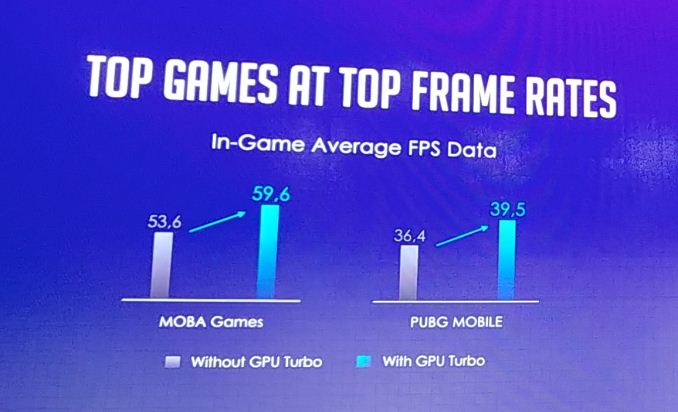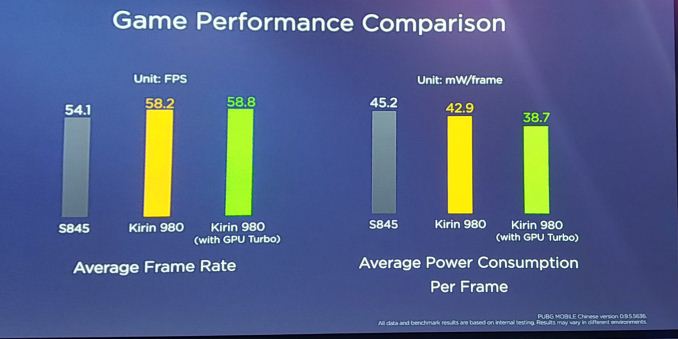Huawei’s GPU Turbo: Valid Technology with Overzealous Marketing
by Ian Cutress & Andrei Frumusanu on September 4, 2018 9:00 AM EST- Posted in
- Smartphones
- Huawei
- Mobile
- Benchmarks
- honor
- Neural Networks
- Kirin 970
- AI
The Minor Issue of Overzealous Marketing
As mentioned earlier in the piece, the most common numbers from Huawei and Honor about the new technology follow the same pattern: GPU Turbo is going to offer up to 60% extra performance, and 30% better power consumption. Since launch, out of all the marketing materials we have seen, there is exactly one instance where either company expands on these figures. This is in the footnotes of Honor Play’s English global product page, explaining the context of the 60%/30% numbers:

 Honor Play's Product Website GPU Turbo Explanation
Honor Play's Product Website GPU Turbo Explanation
Here is what that tiny bullet point says:
*2 The GPU Turbo is a graphics processing technology that is based on Kirin chips and incorporates mutualistic software and hardware interaction. And it supports some particular games.
Results are based on comparison with the previous generation chip, the Kirin 960.
This is a big red flag. Normally when comparing a new technology, the performance difference should be quoted in an off/on state. So it shouldn’t be too complicated to see as to the fact that using the Kirin 960 as the base result is a pretty massive issue. It means that the marketing materials are mixing up its claims – values that are explicitly being attributed to GPU Turbo, a software technology, are mixed with silicon improvements between two generations of chipsets.
The honest comparison should be the Kirin 970 with GPU Turbo off and the Kirin 970 with GPU Turbo on. In this case, the baseline result is with the Kirin 960 with no GPU Turbo, compared against the latest Kirin 970 with GPU Turbo on.
For our readers unfamiliar with the generational improvements of the new Kirin 970 chipset, I recommend referring back to our in-depth article review of chipset released back in January. In terms of advancements, the Kirin 970 brings a new Mali G72MP12 GPU running at 747MHz, manufactured on a new TSMC 10nm process. This represented quite an improvement to the 16nm manufactured Kirin 960 which featured a Mali G71MP8 at up to 1037MHz.
| Kirin 970 | AnandTech | Kirin 960 |
| TSMC 10FF | Mfg. Process | TSMC 16FFC |
| 4xA73 @ 2.36 GHz 4xA53 @ 1.84 GHz |
CPU | 4xA73 @ 2.36 GHz 4xA53 @ 1.84 GHz |
| Mali-G72MP12 @ 746 MHz | GPU | Mali-G71MP8 @ 1035 MHz |
| Yes | NPU | No |
| Cat 18/13 | Modem | Cat 12/13 |
Furthermore, the Kirin 960’s GPU performance and efficiency was extremely problematic, showcasing some of the worst behavior we’ve ever seen in any smartphone ever released. We’re not going to go back as to why this happened, but it was a competitive blow to the Kirin 960.
Now the Kirin 970 improved from these low figures, as we’ve shown in our reviews. But the 60% performance improvements and 30% power improvement mentioned for GPU Turbo, while in isolation might sound impressive, aren't nearly as impressive once we know what they're based on. By being relative to the badly performing Kirin 960, it completely changes the meaning. Users that enable GPU Turbo on their devices will not experience a 60%/30% difference in performance.
This is also in the face of Huawei’s own data presented throughout the lifetime of GPU Turbo. Quoting 60%/30% makes for impressive headlines (regardless of how honest they are), however even Huawei’s own analysis shows that 60%/30% are wildly optimistic:
Ultimately Huawei presented the 60%/30% figures as a differential between GPU Turbo On/Off. If anyone was expecting that on their device, then they would be sorely disappointed. The fact that the companies obfuscated the crucial comparison point of the Kirin 960 is almost unreal in that respect.
Also on that image above, we have to criticize quite heavily on the fact that those bar charts are misrepresenting all the gains: the 3 FPS gain in PUBG is shown as a 25% gain. Companies feel the need to misrepresent the true growth in values like this because it makes for a more impressive graph, rather than adhere to the standard of starting graphs at zero.
Why Using The Kirin 960 Is An Issue: Starting With A Low Bar
Going back to our GPU power efficiency tables measured in GFXBench Manhattan 3.1 and T-Rex, we put the two chipsets back into context:
| GFXBench Manhattan 3.1 Offscreen Power Efficiency (System Active Power) |
||||
| AnandTech | Mfc. Process | FPS | Avg. Power (W) |
Perf/W Efficiency |
| Galaxy S9+ (Snapdragon 845) | 10LPP | 61.16 | 5.01 | 11.99 fps/W |
| Galaxy S9 (Exynos 9810) | 10LPP | 46.04 | 4.08 | 11.28 fps/W |
| Galaxy S8 (Snapdragon 835) | 10LPE | 38.90 | 3.79 | 10.26 fps/W |
| LeEco Le Pro3 (Snapdragon 821) | 14LPP | 33.04 | 4.18 | 7.90 fps/W |
| Galaxy S7 (Snapdragon 820) | 14LPP | 30.98 | 3.98 | 7.78 fps/W |
| Huawei Mate 10 (Kirin 970) | 10FF | 37.66 | 6.33 | 5.94 fps/W |
| Galaxy S8 (Exynos 8895) | 10LPE | 42.49 | 7.35 | 5.78 fps/W |
| Galaxy S7 (Exynos 8890) | 14LPP | 29.41 | 5.95 | 4.94 fps/W |
| Meizu PRO 5 (Exynos 7420) | 14LPE | 14.45 | 3.47 | 4.16 fps/W |
| Nexus 6P (Snapdragon 810 v2.1) | 20Soc | 21.94 | 5.44 | 4.03 fps/W |
| Huawei Mate 8 (Kirin 950) | 16FF+ | 10.37 | 2.75 | 3.77 fps/W |
| Huawei Mate 9 (Kirin 960) | 16FFC | 32.49 | 8.63 | 3.77 fps/W |
| Huawei P9 (Kirin 955) | 16FF+ | 10.59 | 2.98 | 3.55 fps/W |
| GFXBench T-Rex Offscreen Power Efficiency (System Active Power) |
||||
| AnandTech | Mfc. Process | FPS | Avg. Power (W) |
Perf/W Efficiency |
| Galaxy S9+ (Snapdragon 845) | 10LPP | 150.40 | 4.42 | 34.00 fps/W |
| Galaxy S9 (Exynos 9810) | 10LPP | 141.91 | 4.34 | 32.67 fps/W |
| Galaxy S8 (Snapdragon 835) | 10LPE | 108.20 | 3.45 | 31.31 fps/W |
| LeEco Le Pro3 (Snapdragon 821) | 14LPP | 94.97 | 3.91 | 24.26 fps/W |
| Galaxy S7 (Snapdragon 820) | 14LPP | 90.59 | 4.18 | 21.67 fps/W |
| Galaxy S8 (Exynos 8895) | 10LPE | 121.00 | 5.86 | 20.65 fps/W |
| Galaxy S7 (Exynos 8890) | 14LPP | 87.00 | 4.70 | 18.51 fps/W |
| Huawei Mate 10 (Kirin 970) | 10FF | 127.25 | 7.93 | 16.04 fps/W |
| Meizu PRO 5 (Exynos 7420) | 14LPE | 55.67 | 3.83 | 14.54 fps/W |
| Nexus 6P (Snapdragon 810 v2.1) | 20Soc | 58.97 | 4.70 | 12.54 fps/W |
| Huawei Mate 8 (Kirin 950) | 16FF+ | 41.69 | 3.58 | 11.64 fps/W |
| Huawei P9 (Kirin 955) | 16FF+ | 40.42 | 3.68 | 10.98 fps/W |
| Huawei Mate 9 (Kirin 960) | 16FFC | 99.16 | 9.51 | 10.42 fps/W |
So while the Kirin 970 is an advancement and improvement over the 960 – in the context of the competition, it still has trouble holding up with this generation’s Exynos and Snapdragon.
The key point I’m trying to make here in the context of GPU Turbo claims, is that the 60%/30% figures are very much unrealistic and extremely misleading to users. If Huawei and Honor are not clear about the baseline comparisons, the companies' own numbers can never be trusted in future announcements again.
How Much Does GPU Turbo Actually Provide?
On Friday Huawei CEO Richard Yu announced the new Kirin 980, and some of the presentation slides addressed the new mechanism, showcasing a more concrete figure of the GPU Turbo effects on the newly released chipset:
Here, the actual performance improvement is rather minor because the workload is V-sync capped and the GPU doesn’t have issues in that regard, however the power improvements should be still representative. Here the actual power improvement was 10% - something that’s a lot more reasonable and believable improvement that can be attributed to software.












64 Comments
View All Comments
jjj - Tuesday, September 4, 2018 - link
Good first step but could be expanded well beyond the GPU and the entire system built around it.Been thinking about this for some years and could lead to very different hardware if you have an NPU manage everything.
ZolaIII - Tuesday, September 4, 2018 - link
NNPU didn't even earn to eat hire. No one will do it better than your self. Switching off two big cores does much more than all this fuss about GPU turbo.mode_13h - Tuesday, September 4, 2018 - link
Not to agree or disagree with your point, but I think you mean "here" instead of "hire".mode_13h - Tuesday, September 4, 2018 - link
You mean like this?https://www.phoronix.com/scan.php?page=news_item&a...
mode_13h - Tuesday, September 4, 2018 - link
Anyway, I'm thinking a deep learning model could probably do a better job at managing core clock speeds and perhaps even deciding whether to schedule certain tasks on big vs. little cores.ZolaIII - Wednesday, September 5, 2018 - link
We (not AI) need to evolve scheduler logic and add SMP affinity flags to processes. Only then game's can begin. Here goes the rain again. By the way thanks for that.mr_tawan - Tuesday, September 4, 2018 - link
Does it raytrace?Manch - Wednesday, September 5, 2018 - link
I think the question that should be asked is:Can it raytrace Crysis?
Lord of the Bored - Wednesday, September 5, 2018 - link
I'd settle for raytracing FEAR.sing_electric - Tuesday, September 4, 2018 - link
This presents a quandary for benchmarking/reviewing: In the past, if a company released drivers that changed the performance of the device while running a specific app, we'd all call it "cheating" if that app was a benchmark. However, by extending the "cheats" to other apps, the user sees real benefits, even though it's the same behavior.It also means that performance numbers have to be taken with even more salt, because the performance on a popular app which has been "Turboed" by Huawei might not be indicative of the performance you see if you only say, play less popular games that Huawei hasn't profiled.